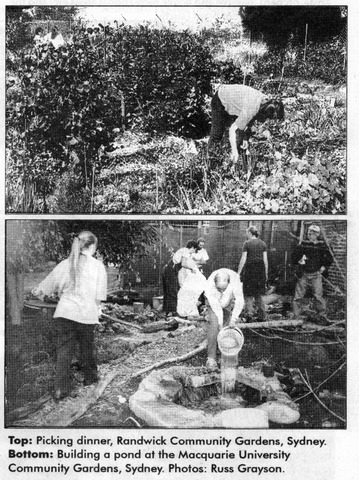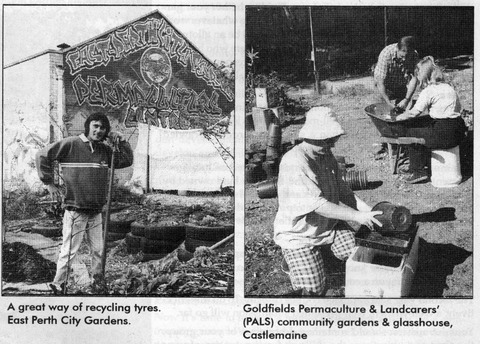By Russ Grayson and Fiona Campbell.
A few weeks ago Russ Grayson contacted me with the offer of stack of magazines called ‘Green Connections’, which was published in Victoria in the late 1990’s. Of course I eagerly accepted, picked them up and am now working my way through them. I saw this article by Russ and Fiona in issue no 14 (Oct/Nov 1997) and was so impressed I had to contact them and ask them if I could reproduce the article here on the Choko Tree. They said yes and so here the article is, reproduced in full, with permission.
Russ Grayson and Fiona Campbell have facilitated the development of many community gardens. Form submissions to contracts and group work they have experienced what works and what doesn’t. Here is invaluable advice for permaculturalists and gardeners who wish to enter the public arena (in a paid or voluntary capacity) to encourage food production in urban areas.
Ring! Ring! Fiona picked the telephone up. “Hello?” “Good morning. I have a grant to hire someone to start a community food garden at our community centre. I wonder if you could tell me the award rate for a permaculturist?”
Yes, it was an improbable call!
The caller was a community centre manager in western Sydney and she had just received a substantial grant to finance the creation of a community garden at her centre. Now she wanted to employ a permaculture designer part time, not only to design the garden but to find, organise and train the gardeners as well.
The job would call for someone with more than the Permaculture Design Certificate. As well as being able to plan a garden site according to the principles of permaculture design, the successful applicant would need people skills such as group facilitation, negotiation and conflict resolution; promotion and publicity skills to target participants; project management skills to design the project, timetable it, estimate and source inputs and manage funds; and teaching skills to carry out the transfer of design and horticultural skills to participants.
These skills are useful to people hoping to work with communities and community organisations to set up and manage community food gardens. Our experience as state coordinators for the Australian City Farms and community Gardens Network, and as community garden designers and trainers, has made it clear to us that the acquisition of such skills is becoming increasingly important for permaculturists working voluntarily or for an income in the community sphere. Designers working with voluntary community garden associations may find that many of these skills exist within the group.
Getting Started:
The process of setting up and city farm or community garden can be seen as a series of linked activities over time. Before we look at how to make a start, lest consider a few points about the process which will encourage participation and a sense of ownership and responsibility by the gardeners.
Participation:
Most community gardens are grassroots developments resulting from the coming together and cooperation of interested people. Participation in decision-making and the taking of responsibility for the garden and the people working in it, are therefore fundamental to successful community gardening.
Especially in the early stage, you will be attending planning meetings. To encourage participation it helps to have access to someone with facilitation skills to run the meeting so that all voices are heard and all opinions taken into account in decision making.
At the same time your meetings, no matter how informally structured, must be business-like and as sort as practical while still allowing time to get through all the business.
Openness:
The community based organisation set up to plan and manage the community garden should ensure that it remains open to new members, to new ideas and changes in direction. Records should be accessible to all to ensure accountability.
Structure:
People sometimes take a laissez-faire attitude to to community garden development, preferring to ‘let it happen’ rather than to develop an effective but relaxed structure to guide garden development. Such prole frequently have an aversion to the planning process and may interpret effective structure as overstructuring. Effective structure and planning, however, are a necessity if your group is to take responsibility for an area of public land and to maintain accountability for its maintenance to the landholder.
Landholders, such as local government, will look more favourably on an organisation displaying effective structure, which is often seen as an indicator of site management ability.
Planning, Designing and Implementing:
Now it’s time to look at a model process for setting up a community garden. We should keep in mind, however, that there is no single way to go about this.
The process which follows should be adapted you your particular circumstances. You might, for instance, already have land; or perhaps you’re like the community worker at the start of this story who has the crucial resources of land and funds but lacks the most important resource for any community garden – a community … people.
The point is to adapt the flow of the process to suit your circumstances. Let’s make a start….
Phase 1 Developing the Vision
In this initial phase, we clarify why we want to start a community garden and what we hope to achieve. If you are likely to play a role in the skills transfer to inexperienced gardeners, plan to spend a minimum two years with the project to nurture it – that is the time frame we have found necessary to pass on horticultural, design and organisational skills.
For community garden animators – people who assist others to establish community gardens – the aim is to plan yourself out of the project by passing on skills so the gardeners become self-managing as they take over your role.
Now is the time to promote your idea for a community garden and bring in new people. Organise a meeting, develop your aims and define a set of objectives which will help you achieve your aims. Gain group agreement to the aims and objectives so that all feel that they ‘own’ the idea.
Phase 2 Collecting Background Information
This is the research phase of community garden development. Do a skills audit to discover what talents and abilities are available within the group.
During this phase, visit other community gardens to collect information on how they started, what type of organisational structure they have, what they do about public liability insurance, where they obtain their resources, their links to local government, how they are funded, where their seeds come from and how they pass on skills to new gardeners and how they improve their own skills. It is during this phase that you decide whether your garden is to be a shared garden – in which people do whatever work is necessary at the time – or whether yours will be an allotment garden with plots held individually by gardeners who have exclusive rights to what they grow as well as well as full responsibility for their plot. Many gardens combine shared and allotment plots.
Phase 3 Finding a Site
Having set up your organisation, it’s time to find a site. Don’t be too ambitious – a small, well managed site is less draining on your time and resources than a site with gardens sprawled higgledy- piggledy over the landscape.
Community gardens are most commonly located on local government land, however you will find them on land owned by schools and universities, churches and hospitals. A useful way to approach the gaining of access to public land is to approach your local council with a site in mind or for advice on where a site might be found.
There are two ways to do this. The first is to approach councillors, especially those known to be amenable to the idea. They might advise you on a course of action.
The second way is to approach council directly. To do this effectively, a well-written, well presented submission will go far.
Your submission should contain: a description of your group; the aims and objectives; the skills and competencies of your members; your actual or proposed legal structure (eg incorporated association); case studies of other community gardens, particularly those in the same city; potential sources of funding grants or other avenues for fund raising; what lease arrangements you would prefer; what you would require from council; how you manage foreseeable risks; the advantages of community gardens for the community and for councils.
Draw up a brief management plan outlining the maintenance work which would likely be required of any site to help convince council of your organisational capacity to responsibly manage a garden.
Present this material to council’s strategic planning or other relevant section. Arrange a meeting with decision makers to take them through the submission, to talk through their concerns and convince them through your competent manner that they can entrust you with a piece of council land.
Phase 4 Negotiating the Lease
Let’s make the assumption that you have been granted access to land. Don’t expect to find land immediately – it sometimes takes a while. Keep in mind that you might be knocked back a number of times, especially if council insists on a community consultation with the neighbours of your preferred site.
Characteristically, neighbours are concerned about noise, aesthetics, pollution, traffic, impact of the garden on their property values and vandalism. Your submission might address these issues to indicate that your group intends to develop ways to effectively deal with them.
Try to negotiate a written lease with the landholder – security of tenure is important to maintaining group motivation. While many community gardens have only informal, verbal arrangements for access to their site, a written lease is a better guarantee of tenure and provides the sense of secutiy necessary to the contribution of effort.

An initial one year lease will do two things. It will give the landholder the option of discontinuing the access arrangement if the community garden group does not have the motivation to persist with project or fails to maintain the mutually agreed standards of maintenance, and it gives the group time to assess whether the project can be sustained. The arrangement should provide for an option, providing both parties are happy with the site management after one year, for future five year leases.
Phase 5 Understanding Your Site
Go to council and obtain a site survey plan. If this is not available, measure up the site and draw it to scale. We start the design phase with a sector and site analysis.
Identify the wind characteristics and direction, sun and shade patterns through the seasons; pollutants entering the site; rainwater runoff and pooling; wildlife; existing structures (and whether you want to keep them); soil pH and type; dry areas; boggy areas and other site information.
Identify microclimates; pleasant and unpleasant places; problem areas and areas that show opportunities that can be addressed in the design phase. Remember you permaculture design principles – look for connections between things; place related things close together; find more than one use for things (multifunction). This forms the foundation for your site base plan.
Phase 6 Designing Your Garden
Next you identify the features you want on site. List the things you would like on site (such as play areas for children, seating areas, orchard, passive and active recreation areas etc.) and the things you might not want (such as agricultural chemicals if you want an organic garden – bees if people are allergic to their sting etc).
Locate these thing on your base plan. You may do several layouts before you are happy that your layout has taken into account your site conditions and everyone’s needs.
Finally, draw up a final design. This guides the implementation of the community garden. Other parts of the project design document include identification of the resources needed and where they are likely to come from; budgeting for the different work chunks, if appropriate; financial management and the publicity/promotional plan.
The entire design phase should be participatory, with site information collection carried out as practical workshops to pass on design skills to the gardeners. This completes the design planning stage.
Phase 7 Building the garden
This is the implementation phase –the time when you put into action the design you have developed. Construction of garden beds, soil improvement, pathway construction, compost making, propagation of of planting material, building of a storage shed and a pergola or shelter for the gardeners are some activities during the implementation stage.
Now is the time to draw up a timeline. It is the timeline which schedules what is done and when. To make a timeline list all the chunks of work needed to build the garden. List these in a sequential order. Now we can schedule them on the timeline. Plot the work chinks in a column. Now plot a year divided into months across the top of the page. Plot the time estimated to complete each work chunk as a horizontal line according to its start and finish time.
From this process you end up with an estimate of the time needed to complete each work chunk, which chunks have to be completed before a following work chunk can be started, and which chunks can be done at the same time. Don’t be too ambitious – allow plenty of times to complete the chunks – things usually take longer than anticipated. This is your timeline and it will guide you through the following implementation phase of your garden project.
May we suggest that, at the start of the implementation phase, you not only construct a tool storage shed and garden beds, but that you build some kind of shelter where the gardeners can congregate, brew a pot of tea or coffee and socialise. We have found that people join community gardens for social reasons as much as for growing food. Community gardens, therefore, have and important community-building function.
The construct phase ended and the first seeds in the soil, it is time to implement the management plan. The management plan schedules recurring tasks such as plant propagation, planting calendar, compost production, site maintenance and risk assessment for safe public access. The scheduling of social events, management meetings and workshops is also programmed into the management plan.

A Rudimentary Sketch
This is, as said before, a rudimentary sketch for a community garden development project. As for assistance, try contacting permaculture associations or designers, and organic gardening associations.
There is little written material to help you set up a community garden, a condition the Australian city Farms and Community Gardens Network intends to redress.
In the 20 years since this was written the ACF&CGN has gone from strength to strength and their website (linked above) is well worth a visit.


